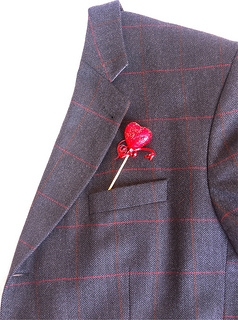February 10th, 2017

Did you know the actions leading to the beginnings of Valentine's Day were actually centered on the avoidance of war? A Catholic priest named Valentine defied the orders of the Emperor Claudius II and secretly married young men and their brides after the emperor had declared it illegal because only single, young men could be sent to war. Rather than lose potential soldiers to fight his war, Claudius attempted to hoard them by proclaiming marriage illegal.
Valentine continued to marry young couples anyway and, eventually, was put to death for it in 270 AD. Before his death, he sent a letter to a secret love and signed it “From your Valentine”. Nearly 1,800 years later, people are still signing letters and cards in this manner. This year, carry on the tradition started long ago, while adding your own twist. Here are a few suggestions.
Simple and Creative Valentine's Day Ideas
- Memorialize it with a Photo. Couples often have photos taken around Christmas, but Valentine's Day photos allow you to capitalize on romance. Famous couple Julia Child and her husband, Paul, had their picture taken together every Valentine's Day and included their sense of humor with silly props.
- Return to Your First Date Location. Even if your first date together was at a local hotdog stand, its sentimental value can make it a fun part of your Valentine's Day agenda. Be creative and make a treasure hunt with clues that lead your partner to the original date location, where you can express your love with flowers or a gift.
- “From Your Valentine” Messages. Deliver your message in a creative way to make this Valentine's Day stand out from the others. Bake your partner's favorite treat and write a message on it with a tube of icing, or draw a note on the steamed up mirror so it shows up when your partner takes a shower.
Although Valentine's Day is a day to celebrate love, it doesn't have to be a special day only for couples. If you're single, use this special day to shower yourself with love, because you're worth it! After all, the priest Valentine believed so strongly in the sanctity of love that he was willing to risk his life for it. Whether you're in a relationship or single, young or old, romantic or not, Valentine's Day is for you. Happy Valentine’s Day from the General Dentistry office of Dr Karina Gregg.
February 3rd, 2017

Nobody likes a dry mouth. It is an uncomfortable and sometimes oddly unexplainable sensation that most people like to avoid. It is not a condition that automatically sends you into a panic about your health, however, a dry mouth can be a bother and something you certainly want to change if possible. So, if you find yourself in the unpleasant position of having a dry mouth, here is what you can do.
Chew Sugar-free Gum: Chewing sugar-free gum will stimulate saliva in your mouth. The chewing motion of your jaw and teeth should take care of at least some of your dry mouth problem.
Suck on Sugar-free Candy: Similarly to chewing sugar free gum, if you suck on sugar free candy it should create more saliva in your mouth and moisturize it in the process.
Cut out the Caffeine:Caffeine can contribute to a dry mouth so by limiting, or eliminating your intake all together, you may find that your dry mouth is no more.
Stop Using Tobacco Products: Tobacco is another cause of dry mouth. Whether it is smokeless tobacco products or cigarettes, if you stop using them your dry mouth will likely improve. And not to forget, these products are exceedingly bad for your oral health to begin with, so you will be doing your mouth a favor even more so.
Drink Lots of Water: It may seem obvious, but drinking lots of water will likely improve your dry mouth. This is because dry mouth is usually a sign of dehydration, so plenty of fluids will surely help.
Dry mouth can be unpleasant, but it is often easily solved by either drinking more water, or trying one of the previously mentioned techniques. If the problem still persists you can always visit our San Marcos, CA office to see Dr Karina Gregg. More often than not, doing one of the above will leave your mouth more moisturized than it was previously, and hopefully it will be long-lasting as well.
January 27th, 2017

Sawing wood. That’s what your wife calls it when you wake her up with your snoring. This type of scenario plays out in homes around the world, and couples have to find a way to make light of the nocturnal annoyance. Snoring can become more than just an irritating nighttime disturbance, however. It can be the first sign of a potentially serious sleep disorder.
Sleep apnea is a disorder in which breathing repeatedly pauses throughout the night. Possible symptoms of sleep apnea include snoring loudly and feeling tired after a full night’s sleep.
Three health problems linked to sleep apnea
Sleep apnea often goes undiagnosed and untreated, which puts you at a greater risk of developing health problems. While being robbed of quality sleep can take its toll on you, sleep apnea can also result in the following.
- High blood pressure. When you wake frequently throughout the night, it causes your body's hormonal systems to become unbalanced and go into overdrive. This results in high blood pressure.
- Heart disease. The disrupted oxygen flow caused by sleep apnea increases your chances of having a heart attack or stroke. The cutoff of oxygen makes it difficult for the brain to regulate the flow of blood in the arteries.
- Excessive daytime sleepiness. Daytime fatigue often results in impaired judgment and slow reaction times, and this may increase your risk of being involved in a motor vehicle accident.
Lifestyle changes like losing weight, avoiding alcohol, and quitting smoking are often enough to cure sleep apnea. Medical treatment is also a potential solution. Surgery, oral appliances, and continuous positive airway pressure (CPAP), which is a treatment involving a specialized breathing mask, are all possible ways to resolve the problem of sleep apnea.
If you think you may be suffering from sleep apnea, or to schedule a visit with Dr Karina Gregg at our convenient San Marcos, CA office, please give us a call! Our entire team at San Elijo Dental look forward to giving you back a full night’s rest!
January 20th, 2017

As you grow older, your mind may be preoccupied with the health of your bones, heart, or brain. However, our team at San Elijo Dental will tell you that keeping your teeth healthy is an equally important part of the aging process. Older adults are at increased risk for a variety of oral health conditions, which makes it essential for you to speak with your dentist to create a prevention plan that’s best for you.
Oral health conditions associated with aging
Just as the rest of your body continues to change as you age, your mouth changes, too. Certain conditions become more likely to develop as you reach older adulthood, including:
- Dry mouth. Although your salivary glands continue to produce saliva as you get older, medications and chronic health problems often cause dry mouth.
- Root decay. Your teeth have lasted you a lifetime, but improper nutrition or cleaning may lead to decay at the roots of your teeth.
- Diminished sense of taste. Your eyesight and hearing aren’t the only senses affected by aging. The ability to taste naturally diminishes over the course of older adulthood.
- Tissue inflammation. Are your gums tender, bleeding, or inflamed? Tissue inflammation may indicate gum disease or may be a consequence of wearing dentures that don’t fit well.
- Oral cancer. Risk for most cancers increases with age, and oral cancer is no exception. Older adults are at increased risk for oral cancer compared to younger individuals.
Ways you can prevent dental problems
Fortunately, many age-related oral health problems are preventable. Begin by improving your diet to include plenty of fruits and vegetables. Choosing water over coffee or soda will keep your teeth whiter and cavity-free. Also remember to practice good brushing habits to prevent cavities and gum disease.
Visiting the dentist at least twice a year is vitally important when you reach older adulthood. Your dentist is familiar with your oral health and may be the first person to notice a sore, discolored patch, inflammation, or other abnormality that indicates oral cancer or gum disease.
If you’re experiencing any problems with dental health, let your dentist know immediately. Together, you can troubleshoot solutions and create a plan that keeps your mouth and gums healthy.
For more information, or to schedule an appointment with Dr Karina Gregg, please give us a call at our convenient San Marcos, CA office!







 Website Powered by Sesame 24-7™
Website Powered by Sesame 24-7™